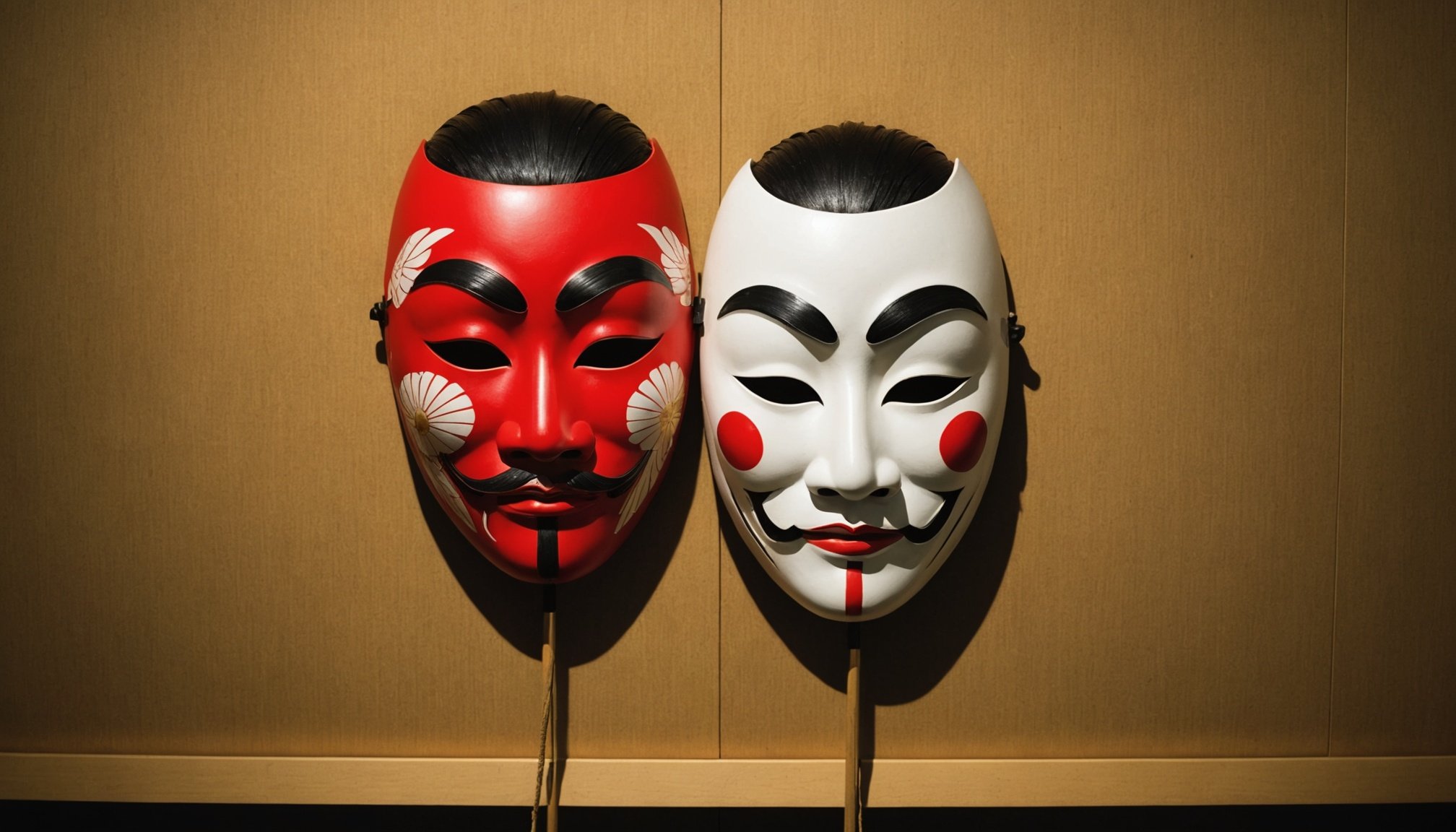Unveiling the Cultural Significance of Japanese Theater Masks
Japanese theater masks, particularly those from the traditional forms of Noh and Kabuki, hold a profound cultural significance that extends far beyond their use as mere stage props. These masks are intricate pieces of art that embody the essence of Japanese culture, conveying complex emotions, telling stories, and connecting audiences to the rich heritage of Japan.
The Historical Roots of Japanese Theater Masks
To understand the cultural significance of these masks, it is essential to delve into their historical roots. The use of masks in Japanese theater dates back to ancient times, with both Noh and Kabuki theater forms having their own unique histories.
Additional reading : Unleashing potential: the impact of a performance intake manifold on your chevrolet corvette c7
Noh Theatre
Noh theatre, one of Japan’s oldest and most revered art forms, has its origins in the 14th century. It was initially performed for the samurai elite and later became accessible to the general public during the Edo period (1603–1868)2.
In Noh, masks known as Noh-men are hand-carved and beautifully painted, representing various characters such as gods, spirits, demons, and humans. Each mask is highly stylized and symbolic, with minimal facial features that allow for subtle shifts in emotion based on how the actor moves or how the light falls on the mask. The Hannya mask, for example, is a striking symbol of emotional transformation, representing a woman driven to demonic transformation by love and jealousy4.
Also read : Unlock the excitement of mickey's mystery box quest today!
Kabuki Theatre
Kabuki theatre, which emerged in the 17th century, also uses masks, although they are less prevalent than in Noh. Kabuki masks are often more expressive and are used to capture the emotions and characteristics of the characters on stage. These masks are made from various materials, including wood, papier-mâché, and modern plastics, each offering a different texture and weight that influences how the mask is worn and perceived1.
The Cultural Significance of Masks in Japanese Theatre
The cultural significance of these masks can be understood through several key aspects:
Emotional Expression
Masks in Japanese theatre are not just physical objects but tools for conveying deep emotional and spiritual undercurrents. In Noh, the masks allow actors to transcend their individual identities and connect to larger, more universal emotions. The subtle shifts in facial expressions, achieved through the angle and movement of the mask, invite the audience to interpret the emotional nuance behind the performance2.
Symbolism and Meaning
Each mask has a specific symbolism and meaning. For instance, in Kabuki, the colors used on the masks are not arbitrary but follow a precise code. Red symbolizes virtue and passion, black represents intrigue and mystery, and white signifies purity or sometimes death1.
In Noh, the Oni mask, which represents demons or ogres, is a powerful symbol with paradoxical meanings. These masks can signify both malevolence and protection, making them fascinating figures rich in cultural symbolism3.
Materials and Motifs of Japanese Theater Masks
The materials and motifs used in the fabrication of these masks are equally significant.
Materials
Traditionally, Noh masks are made from wood, while Kabuki masks can be made from wood, papier-mâché, or modern plastics. Each material offers a different texture and weight, influencing how the mask is worn and perceived. For example, wooden masks are often heavier and more rigid, while papier-mâché masks are lighter and more flexible1.
Motifs
The motifs on these masks vary greatly depending on the roles and stories being told. In Noh, the masks represent a variety of characters, including gods, spirits, demons, and humans. The designs are highly stylized and symbolic, with minimal facial features that allow for subtle shifts in emotion.
Here is a detailed list of some common motifs and their meanings:
- Hannya Mask: Represents a woman driven to demonic transformation by love and jealousy.
- Oni Mask: Represents demons or ogres, signifying both malevolence and protection.
- Kitsune Mask: Represents the fox spirit, often associated with cunning and intelligence.
- Fukai Mask: Represents a woman experiencing strong emotions, often used in Noh plays to depict sorrow or joy5.
Incorporating Japanese Theater Masks into Modern Culture
Japanese theater masks have transcended their traditional roles and are now integrated into various aspects of modern culture.
Fashion and Streetwear
In recent years, there has been a growing trend of incorporating traditional Japanese masks into modern fashion, particularly in streetwear. Designers and fashion enthusiasts are finding innovative ways to integrate these masks into their outfits, from casual looks to high-fashion designs.
For example, a masque oni can be worn as a pendant on a long necklace to complete a minimalist casual look, or it can be integrated as a belt to add a sophisticated touch to an urban chic outfit3.
Festivals and Events
Japanese theater masks are also commonly seen at various festivals and events in Japan. Participating in these festivals while wearing a traditional mask can be a fantastic way to immerse oneself in Japanese culture. For instance, during the spring, one might opt for a light and airy outfit with pastel colors, using the mask as a striking contrast. In the summer, breathable fabrics and floral motifs inspired by summer festivals can add a festive touch1.
Preserving the Tradition
Despite the modern adaptations, the traditional aspects of these masks are meticulously preserved.
Noh Theatre Today
Noh theatre remains remarkably unchanged over the centuries. Its performance style, stage design, costumes, and masks have all been preserved with great care, ensuring that modern audiences experience Noh much as it would have been performed hundreds of years ago. Noh is recognized as one of Japan’s three major classical theatres and has been designated as a UNESCO Intangible Cultural Heritage2.
Kabuki Theatre Today
Kabuki theatre also continues to thrive, with its masks and costumes being an integral part of its performances. The use of masks in Kabuki, though less prevalent than in Noh, still plays a crucial role in capturing the emotions and characteristics of the characters on stage1.
Practical Insights and Actionable Advice
For those interested in incorporating Japanese theater masks into their lives, here are some practical insights and actionable advice:
Understanding the Symbolism
Before incorporating a mask into your outfit or using it in any context, it is essential to understand its symbolism and meaning. For example, the Oni mask represents both malevolence and protection, so wearing it should be done with an appreciation of its cultural significance3.
Choosing the Right Mask
Select a mask that respects the theme of the event or the season. For instance, during autumn, masks with warm, golden details or deep red hues can complement the seasonal colors1.
Integrating Masks into Daily Life
Porting a Japanese theater mask can be a powerful way to express hidden aspects of your personality. Whether it is during a special event or a casual stroll, these masks allow you to push the boundaries of conventional fashion and connect with a deep cultural heritage.
Here are some examples of how to integrate masks into different seasonal outfits:
- Spring: Opt for light and airy outfits with pastel colors. The mask can serve as a striking contrast while remaining harmonious with soft tones.
- Summer: Choose breathable fabrics and floral motifs inspired by summer festivals.
- Autumn: Warm hues like orange and brown work well with masks adorned with golden or deep red details.
- Winter: Associate your mask with elegant coats and voluminous scarves. Neutral colors like black and gray highlight the art of the mask without stealing the show1.
Japanese theater masks are more than just artifacts of a traditional art form; they are living embodiments of Japanese culture and history. Whether you are attending a traditional festival, incorporating them into modern fashion, or simply appreciating their artistic value, these masks offer a profound connection to the emotional, spiritual, and cultural depths of Japan.
For a deeper dive into the art and history of Japanese theater masks, you can explore resources like this comprehensive guide.
By understanding and respecting the cultural significance of these masks, we can continue to appreciate and preserve this unique aspect of Japanese heritage for generations to come.
Table: Comparison of Noh and Kabuki Masks
| Aspect | Noh Masks | Kabuki Masks |
|---|---|---|
| Materials | Traditionally made from wood; also found in papier-mâché and modern plastics | Made from wood, papier-mâché, and modern plastics |
| Design | Highly stylized and symbolic with minimal facial features | More expressive and detailed |
| Usage | Used to represent gods, spirits, demons, and humans | Used to capture emotions and characteristics of characters |
| Symbolism | Each mask has a specific symbolism and meaning | Colors and designs follow a precise code |
| Performance Style | Part of a highly controlled and restrained performance style | Part of a more dynamic and expressive performance style |
| Cultural Significance | Integral part of Noh theatre, a UNESCO Intangible Cultural Heritage | Integral part of Kabuki theatre, reflecting Japanese cultural heritage |
| Modern Adaptations | Incorporated into modern fashion and streetwear | Incorporated into modern fashion and streetwear |
Quotes and Insights
- “By wearing masks, Noh actors can become ancient gods, tragic ghosts, or vengeful spirits, transcending their individual identities and connecting to larger, more universal emotions.”2
- “The Hannya mask emerges as a striking symbol of emotional transformation, representing a woman driven to demonic transformation by an unrelenting tide of love and jealousy.”4
- “Porting a Japanese theater mask can be a powerful way to express hidden aspects of your personality and connect with a deep cultural heritage.”1
By exploring the world of Japanese theater masks, we uncover not only a rich cultural heritage but also a profound means of emotional expression and artistic beauty.











